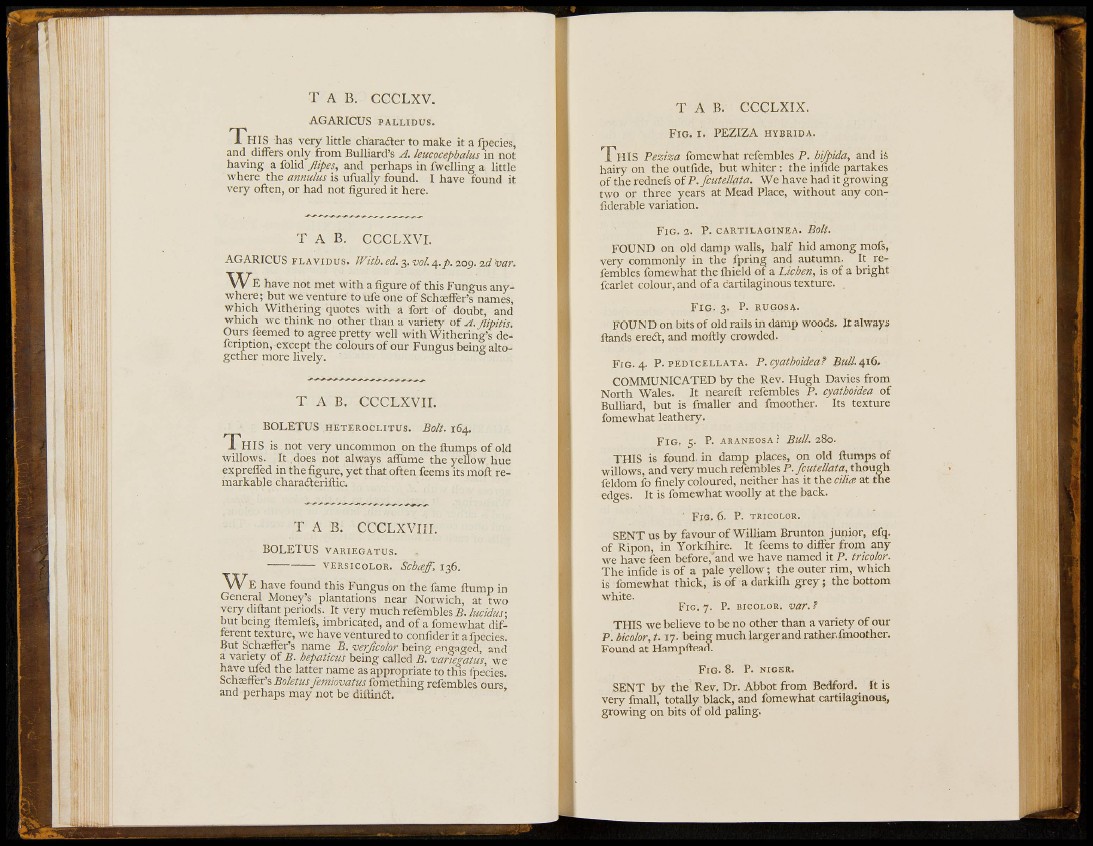
B 9
i iiii:
T A B. CCCLXV.
AGARICUS PALLIDUS.
T H I S has very little charadter to make it a fpecies,
and differs only from Bulliard's A. leucocephalus in not
having a folid Jiipes, and perhaps in fwelling a little
where the annulus is ufually found. I have found it
very often, or had not figured it here.
T A B . CCCLXVI.
AGARICUS FLAViDus . With. ed. 3. vol. ¡¡¡.p. 209.2d var.
W E have not met with a figure of this Fundus anvwhere;
but we venture to ufe one of Schseffer's names,
which Withering quotes with a fort of doubt, and
which we think no other than a variety oi A. Jlipitis.
Ours feemed to agree pretty well with Withering's defcription,
except the colours of our Fungus being altogether
more lively.
T A B. CCCLXVII.
BOLETUS HETEROCLITUS. Bolt. 164.
T H I S is not very uncommon on the flumps of old
willows. It .does not always afl^ume the yellow hue
expreffed in the figure, yet that often feems its moft remarkable
charaileriftic.
T A B . CCCLXVni.
BOLETUS VARIEGATUS.
VERSICOLOR. Schceff. 136.
W E have found this Fungus on the fame ftump in
General Money's plantations near Norwich, at two
very diftant periods. It very much refembles B. lucidus-,
but bemg ftemlefs, imbricated, and of a fomewhat different
texture, we have ventured to confider it a fpecies.
But Schaeffer's name B. verftcolor being engaged, and
a variety of B. hepaticus being called B. variegatus, we
have ufed the latter name as appropriate to this fpecies.
Schaeffer's Boletus femiovatus fomething refembles ours
and perhaps may not be diftinift. '
T A B. CCCLXIX.
FIG. I. PEZIZA HYBRIDA.
T H I S Peziza fomewhat refembles P. hifpida, and is
hairy on the outfide, but whiter: the infide partakes
of the rednefs of P.fcutellata. We have had it growing
two or three years at Mead Place, without any confiderable
variation.
FIG. 2. P. CARTILAGINEA. Bolt.
FOUND on old damp walls, half hid among mofs,
very commonly in the fpring and autumn. It refembles
fomewhat the lliield of a Lichen, is of a bright
fcarlet colour, and of a cartilaginous texture.
F I G . 3. P. RUGosA.
FOUND on bits of old rails in damp woods. It always
Hands ere£l, and moftly crowded.
FIG. 4. P. PEDICELLATA. P.cyathoidea?
COMMUNICATED by the Rev. Hugh Davies from
North Wales. It neareft refembles P. cyathoidea of
Bulliard, but is fmaller and fmoother. Its texture
fomewhat leathery.
FiGr 5- P. AEANEOSA ? Bull. 280.
THIS is found in damp places, on old flumps of
willows, and very much refembles P.fcutellata, though
feldom fo finely coloured, neither has it the cilicR at the
edges. It is fomewhat woolly at the back.
FIG. 6. P. TRICOLOR.
SENT us by favour of William Brunton junior, efq.
of Ripon, in Yorkfhire. It feems to differ from any
we have feen before, and we have named it P. tricolor.
The infide is of a pale yellow; the outer rim, which
is fomewhat thick, is of a darkiilr grey; the bottom
white.
FIG. 7. P. BICOLOE. var. ?
THIS we believe to be no other than a variety of our
P. bicolor, 1.17. being much larger and rather fmoother.
Found at Hampftead.
FIG. 8. P. NICER.
SENT by the Rev. Dr. Abbot from Bedford. It is
very fmall, totally black, and fomewhat cartilaginous,
growing on bits of old paling.